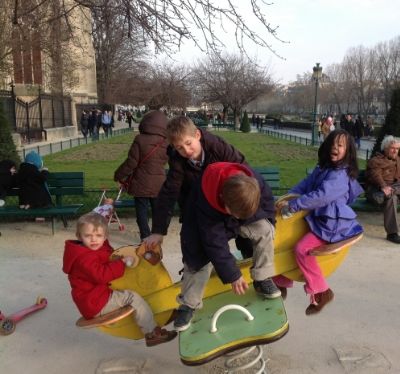Such is the case with reader Jennifer: when she was growing up, she was somewhat embarrassed to use her family's native language of Spanish, and preferred to speak English exclusively. Now an adult, she regrets that decision, and hopes to create a different language vision for her own young family.
Fortunately, in today's world of endless e-resources, it is becoming easier and easier to reconnect with one's roots.
But with all those millions of resources available, where does one even begin, as Jennifer asked, to introduce the language of heritage to a toddler? This question has as many answers as the number of people that you ask... so I'll just share where I began with Mag:
Placemats!
 |
| click for affiliated link |
2) French is my first love, and is the language in which I am strongest, after English. So French is what I wanted to teach Mag... however,
3) This one was the kicker: I have absolutely no French language experience with anyone under the age of 13. Therefore, I don't know kids' vocabulary (like toy names) in French, or French story grammar (as in "and they lived happily ever after"), or many French "comptines" (nursery rhymes), or many French expressions used with children (like "faire dodo," kiddie slang for "to go night-night"). Basically, I didn't know any age-appropriate French to teach my daughter.
 |
| click for affiliated link |
In the sing-songy intonation of American "motherese," which I could only hope worked in French, too, I said, "Qui voudrait un cheerio?" (Who would like a cheerio?) And then I answered myself, still in sing-songiness, "Le cochon. Le cochon voudrait un cheerio." (The pig. The pig would like a cheerio.) And I set the snack on the pig. Then Mag ate it.
After a few rounds of that, I asked the question "Qui voudrait un cheerio?"... but this time I waited for Mag to choose an animal by pointing to it. I then said the animal's name in French, and gave it a cheerio.
Thanks, I'm sure, to the motivation of snacks, Mag quickly learned the M.O.:
- mommy says "qui voudrait something-something,"
- Mag points to an animal,
- Mommy says some word Mag has never heard before (the animal's name in French),
- then a treat appears by the animal Mag pointed to,
- and Mag gets to eat the treat.
 |
| click for affiliated link |
I began to feel as if the sky were the limit: we changed placemats to learn new animals, switched up the sentences ("Qui a faim?" Who is hungry?), used the routine with toys instead of placemats. You name it, if it was in my grown-up repertoire, we adapted it to a child's level.
Sure, I still can't teach my daughter the typical vocabulary a French 5 year old uses. She will not become fully bilingual under my tutelage.
 |
| playing at the park at Notre Dame, Paris |
Nevertheless, she was completely comfortable playing with French children in the parks of Paris, and interacting for hours with her French "cousins." Despite the limitations of my French, Mag's language level made her feel at home enough in France to regularly ask when we can "move back." Success, in my book.
And it all started with a placemat!
Any other not-fully-bilinguals teaching their children their second language?


Awesome post! I can't wait to try this with my boys (1 and 3). I am as you say "not-fully-bilingual" in Spanish. :) Thanks for sharing!
ReplyDeleteHope they love it as much as my LO did at that age! I'm heading to meet your blog right now...
DeleteJulie
I came here via Multilingual Kids Blogs on Facebook.
ReplyDeleteI love this story of such a creative and innovative way of introducing a child to another language. Brilliant!
Yes, I'm so excited to newly be a part of the FB group. I appreciate your welcome and compliment!
DeleteJulie
I started just like you did! I played, but constantly created a context where the meaning of the sounds they heard was clear. And it worked, with lots of time in Mexico thrown in. Thanks for a very fun and useful post. I will send my readers from Spanish Playground this way!
ReplyDeleteSo fun to hear that you've done this and seen good long-term results, since I'm only a few years into the process. I'm even more excited now! And thank you in advance for the new traffic. It's so much more fun having company for the journey!
DeleteJulie
Thanks for sharing on "Juntemos Jueves"!
ReplyDeleteYou're welcome! Thank you for the opportunity!
DeleteI am hoping to start my son on a bit of French (I'm just starting to teach myself) and have been at a loss for where to begin. I will look into the placemats-- they are so cute!
ReplyDeleteIt's such an exciting time, getting started with languages with a little one! Stop back in to share how it's going when you have a chance. It'll be fun to follow along on your journey!
DeleteJulie